Abstract
Surface plasmon resonance (SPR) based sensors play an important role in the biological and medical fields, and improving the sensitivity is a goal that has always been pursued. In this paper, a sensitivity enhancement scheme jointly employing MoS2 nanoflower (MNF) and nanodiamond (ND) to co-engineer the plasmonic surface was proposed and demonstrated. The scheme could be easily implemented via physically depositing MNF and ND overlayers on the gold surface of an SPR chip, and the overlayer could be flexibly adjusted by controlling the deposition times, thus approaching the optimal performance. The bulk RI sensitivity was enhanced from 9682 to 12,219 nm/RIU under the optimal condition that successively deposited MNF and ND 1 and 2 times. The proposed scheme was proved in an IgG immunoassay, where the sensitivity was twice enhanced compared to the traditional bare gold surface. Characterization and simulation results revealed that the improvement arose from the enhanced sensing field and increased antibody loading via the deposited MNF and ND overlayer. At the same time, the versatile surface property of NDs allowed a specifically-functionalized sensor using the standard method compatible with a gold surface. Besides, the application for pseudorabies virus detection in serum solution was also demonstrated.
1. Introduction
Biological analytes detection is significant research because it plays a vital indicator for biomedical evaluation. With the development of modern medical testing technology, optical and electronic sensors to detect extremely dilute concentrations and small molecular weights of analytes have raised great interest in recent years [1]. As one kind of optical sensor, the sensors based on surface plasmon resonance (SPR) have shown great application potential in the detection of biochemical molecules due to their advantages of label-free, real-time, online monitoring, etc. [2]. SPR is a physical phenomenon that occurs at the interface of a dielectric and metal; the surface Raman scattering (SERS) is enhanced by the metal layer on the surface [3], and it is very sensitive to medium refractive index (RI) changes of sensing layer [4,5]. However, improving the sensitivity of SPR sensors is a goal that has always been pursued regarding detecting biomolecules with small weight or ultra-low concentration [6].
It has been proved that well-engineering the plasmonic surface by nanostructure or nanomaterial can effectively improve sensitivity [7,8]. One of the commonly-adopted schemes is to replace the conventional single metal film with a well-designed metal nanoarray structure, such as nanostrips [9] and nanorods [10] on the metal layer. In this way, the sensor’s sensitivity can be improved to a high level of 10,000–30,000 nm/RIU [11,12]. Moreover, the metal-insulator-metal (MIM) waveguide can form a double-cavity structure, providing the potential for temperature compensation by monitoring the two resonance wavelengths [13]. In these cases, the sensing field on the sensor surface was enhanced by the polariton coupling from the additional nanostructure, significantly increasing the penetration depth and sensitivity. However, the fabrication of these nanostructures needs complicated processes, such as electron-beam lithography. Using a multilayer thin-film structure, such as a hyperbolic metamaterial composed of alternant metal/dielectric films [14,15,16], can alleviate the complicated process. Our recent work demonstrated that tuning the angle of incidence can achieve large penetration depths to 1800 nm, yielding a theoretical sensitivity of ~105 nm/RIU [17]. An alternative and easy implementation scheme is attaching nanomaterials to the surface of a metal plasmonic layer by chemical modification or physical deposition [18]. Different forms of nanomaterials, including nanoparticles (such as Au [19] and TiO2 [20]), nanotubes, such as halloysite [21], two-dimensional materials (such as graphene oxide [22,23], MoSe2 [24], GeSe [25], Mxene [26], antimonene [27]), and so on have been demonstrated to improve SPR sensitivity. MoS2 is a cheap and abundant mineral, and its nanocomposites with Ni and gold are used in electronic, magnetic, and catalytic applications [28]. Our recent works [29,30] showed that depositing MoS2 nanoflower (MNF) on a metal film surface not only improved the bulk RI sensitivity via engineering the plasmonic coupling condition but also provided more loading sites for biological probes, which is beneficial to high-sensitivity biological sensing.
In this paper, we proposed a scheme using MNF and nanodiamond (ND) to co-engineer the plasmonic surface for sensitivity-enhanced biosensing. In this scheme, the advantages of MNF and ND were combinedly exploited. MNFs can provide sufficient sensing sites because of their flower-like morphology; at the same time, thanks to the versatile surface property of ND, the specific modification of the sensor can be easily implemented. Moreover, the high values in dielectric constant possessed by MNF and ND help to improve the intrinsic RI sensitivity, which are studied by both experiments and theories. The sensitivity improvement in biological detection was demonstrated by the IgG antigen-antibody binding process in a PBS solution, where the sensor showed good specificity as well. Besides, the practical application of a sensor for pseudorabies virus (PRV) in serum solution was also demonstrated.
2. Materials and Methods
2.1. Materials and Reagents
A combination of 3-mercaptopropionic acid (MPA), N-hydroxysuccinimide (NHS), 1-ethyl-3-(3-dimethylaminopropyl) carbodiimide (EDC), and ethanolamine were utilized to chemically modify the surface of SPR chip. Hexaammonium heptamolybdate tetrahydrate ((NH4)6Mo7O24·4H2O) and thiourea (CH4N2S) were used to synthesize MNF. The materials mentioned above were brought from the Shanghai Aladdin Company. Carboxylated NDs with an average size of 35 nm were purchased from the Taiwan FND Biotech Company. PBS was purchased from the Shanghai Sangon Biotech Company. Goat-anti-mouse IgG, mouse IgG, rabbit IgG, and bovine IgG were purchased from the Beijing Biosynthesis Biotechnology Company. PRV, PRV antibody, and pig serum samples were extracted from samples collected on the farm. PRV and PRV antibodies were dissolved in a mixture of pig serum and PBS (3:100 v/v). IgG reagents, PRV, PRV antibody, and serum sample were stored at −20 °C, and other reagents were stored at −4 °C.
2.2. Synthesis of MNF
MNF powders were synthesized by the one-pot hydrothermal method. Firstly, the homogeneous solution was prepared by mixing 1.24 g of hexaammonium heptamolybdate tetrahydrate [(NH4)6Mo7O24·4H2O] and 2.28 g of thiourea in 35 mL deionized water. The received homogeneous solution was then transferred into a 50-mL Teflon-lined stainless-steel autoclave. The temperature in the autoclave was increased to 200 °C for about 12 h, then cooled to room temperature. Finally, the acquired black product was rinsed repeatedly with deionized water and absolute ethanol and then dried at 60 °C for 12 h.
2.3. SPR Chips Preparation
SPR chips were fabricated on tailored silica slides at 28 × 20 × 1 mm (Jiuyi Optics, Fuzhou, China). The slides were first washed several times with deionized water and absolute ethanol. We have investigated the effect of gold film thickness [31] on the performance of SPR sensors, and according to the relevant results, the best performance of SPR sensors was obtained with a gold film thickness of 50 nm. So, a 5 nm thickness chromium layer and a 50 nm gold layer were successively coated on the slide surface by vacuum thermal evaporation, where the chromium layer was used to strengthen the adhesion of the gold layer on the slide. According to our previous related work [30], continued deposition of ND on a chip deposited once with MoS2, the MNF and ND dispersion solutions with the respective concentrations of 0.025 mg/mL and 0.05 mg/mL were prepared in ethanol/water (1:1 v/v) solvent with the aid of sufficient sonication for at least 30 min. Then a 200 μL MNF or ND dispersion solution was deposited onto the gold film and dried at room temperature for at least 12 h. Through repeating the above process of drop-casting and drying, multilayers of MNF or ND can be attached to the gold surface of the SPR chip.
2.4. Specific Modification on Chip Surface
Figure 1 shows the modification process and detection diagram. The chip coated with MNF and ND was first incubated in PBS solution for 30 min to soak the chip surface. Then, 10 mM MPA solution was used to replace PBS and incubated for about 60 min. The MPA was washed away by PBS, and then the EDC/NHS (1:1 v/v) mixture was added to the chip to activate the carboxyl groups on the gold surface. Afterward, 150 μg/mL antibody solution was incubated on the chip surface for 120 min and then washed with PBS. In the cases of IgG and PRV detection, the goat-anti-mouse IgG and PRV antibodies were employed, respectively. The chip was specifically functionalized as a result. Finally, 1 M of ethanolamine solution was added to occupy the remaining blank sites, suppressing nonspecific binding in the following detection process.
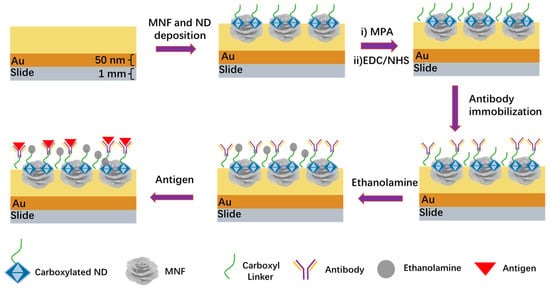
Figure 1.
Schematic diagram of chemical modification and analyte detection on the chip surface.
2.5. IgG Immunoassay
The sensor chip immobilized with goat-anti-mouse IgG was exposed to mouse IgG solutions with different concentrations (5, 10, 20, 50, 100, 150, and 200 μg/mL) to measure immunoassay performance. Mouse IgG solutions were measured from low-to-high concentration successively, and each concentration solution was incubated on a chip surface for 30 min. Then chip surface was washed with PBS several times before proceeding to the next concentration. Each concentration was measured 3 times to evaluate the repeatability. The transmission spectrum of the sensor was real-time detected and recorded by a wavelength-interrogated SPR test system (see Section S1 in Supporting Information for details), where the SPR chip was mounted on a prism, as shown in Figure 2.
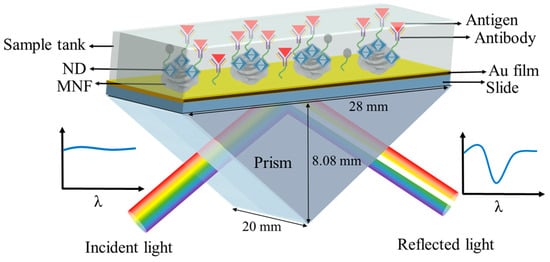
Figure 2.
Schematic diagram for SPR immunoassay where the sensor chip was mounted on a prism.
2.6. PRV Immunoassay
In addition, the SPR chip modified with PRV antibody was applied to PRV detection in a serum environment. PRV solutions with different concentrations (0, 0.5, 1.25, 2.5, 5, and 10 μg/mL), prepared in the solvent of pig serum and PBS mixture (3:100 v/v), were used to measure immunoassay performance. PRV solutions were detected from low to high concentration successively, and each concentration solution was incubated for 30 min. Before proceeding to the next concentration, the chip surface was flushed with PBS several times and then incubated in PBS until the measured signal stabilized.
3. Results and Discussions
3.1. Materials and Chips Characterization
MNF and ND are characterized by scanning electron microscope (SEM), X-ray photoelectron spectroscopy (XPS), Raman spectrometer, and X-ray diffraction (XRD). The SEM image of MNF (Figure 3a) shows the petal-like morphology exposing more faces and edge sites. The particle size of nanoflowers is about 0.5–1 µm. NDs in the SEM image (Figure 3b) show a polyhedron morphology, and the particle size ranges from 30 to 300 nm due to a certain degree of agglomeration. The SEM image on the chip surface deposited by the mixture of nanoflowers and NDs (Figure 3c) indicates that the gap between petals is occupied by NDs. The element composition of materials is demonstrated by XPS (Figure 3d). It also reveals that MNF contains a small number of impurity elements, such as Al and Cu, and ND contains oxygen elements due to the carboxyl functional groups on its surface. Besides, two Raman peaks at 378 cm−1 and 403 cm−1 can be observed for MNF (Figure 3e(i)), which is consistent with what has been reported in other articles [32], and one observed peak for NDs is located at 1431 cm−1 (Figure 3e(ii)). The measured diffraction peaks of MNF in the XRD spectrum (Figure 3f) are matched with the standard pattern of hexagonal MoS2 (JCPDS card No. 73-1508) [33]. The intensity ratio of diffraction peak (100) to (002) is 0.51, which means a large number of crystal faces (100) nanoflowers are exposed [34].

Figure 3.
Characterization of materials. SEM images of (a) MNF, (b) ND, and (c) the chip surface deposited with the mixture of MNF and ND. (d) XPS and (e) Raman spectra of MNF and ND. (f) XRD spectrum of MNF.
The chip’s surface, deposited with MNF and ND, was characterized. Here, we used MNF + ND*n (n = 0,1,2…) to indicate that the chip surface was deposited with MNF for 1 time and ND for n times. Optical microscope images (Figure 4a,b) suggest the MNF and ND were attached to the chip surface. Moreover, the amount of ND particles increases with the modification times, verified by the increased fluorescence intensity emitted from NDs, as shown in Figure 4c,d. As a control, a chip surface modified with MNF only was characterized, and no NDs and fluorescence emission can be observed (Figure S2). SEM images on the cross-section of the chip surface (Figure 4e,f) show that the further deposition of ND on MNF will result in the thickness increase of the overlayer.
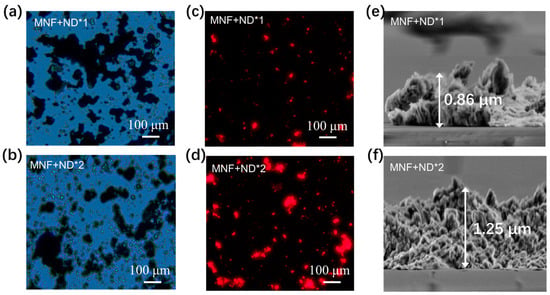
Figure 4.
Characterization of sensor chips. (a,b) Optical microscope images, and (c,d) Corresponding fluorescent images on the chip’s surface deposited with MNF + ND*1 and MNF + ND*2, respectively. The NDs used in our experiments contain a nitrogen vacancy (NV) center, which emits red fluorescence under the excitation of green light [35]. This enables us to evaluate the amount of NDs modified on the chip surface based on the fluorescence intensity. (e,f) SEM images of chips interface from the side view.
3.2. Bulk RI Sensitivity
Bulk sensitivity is a significant parameter to evaluate the performance of an SPR sensor. The bulk RI sensitivity of sensor chips deposited with MNF and ND at various times was characterized by varying the surrounding RI from 1.331 to 1.342 RIU (Figure 5). For each chip, the resonant wavelength shifts to a longer wavelength as the RI increases, but the wavelength shift amounts, namely RI sensitivities, are different, as shown in Figure 5 and Figure S3. The sensitivity gradually increases as MNF and ND are successively deposited on chips, reaching the highest when ND is deposited 2 times. However, the further deposition of ND to 3 times will cause a decrease in sensitivity. Compared with the initial sensitivity of 9682 nm/RIU for the bare Au chip, the highest sensitivity of 12,219 nm/RIU for the Au + MNF + ND*2 chip shows an enhancement of 26.2%. The sensitivity improvement can be attributed to the electric field, namely sensing field enhancement induced by the co-engineering of MNF and ND on the Au surface (see Section S4 in Supporting Information for details). On the other hand, the further deposition of ND results in the increase of thickness of the overlayer on the Au surface, thus reducing the overlap between the sensing field and analyte solution, which leads to the sensitivity degradation for the chip Au + MNF + ND*3 in our case.
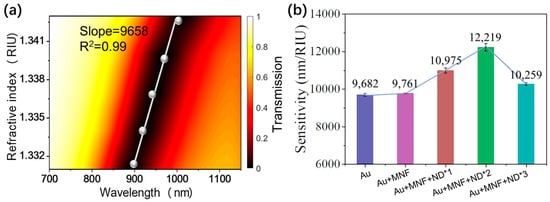
Figure 5.
(a) Measured transmission spectra under varied surrounding RIs for Au chip. RI sensitivity is obtained by linearly fitting the resonant wavelength and RI. (b) Measured sensitivities for different SPR sensor chips.
3.3. IgG Immunoassay Performance
Here, the sensor chips were designed for specific detection of mouse IgG. The chemically-modified Au chip and Au + MNF + ND*2 chip were first incubated with 150 μg/mL goat-anti-mouse IgG for 120 min. As the antibodies immobilized on the chip surface, the resonant wavelength shifted red (Figure 6a,b). Moreover, the shift amount for Au + MNF + ND*2 chip (20.13 nm) was significantly higher than that for the Au chip (11.39 nm). This is not only due to the higher bulk RI sensitivity of Au + MNF + NDs*2 but also because the deposited MNF and ND on the Au surface provide more antibody loading sites.
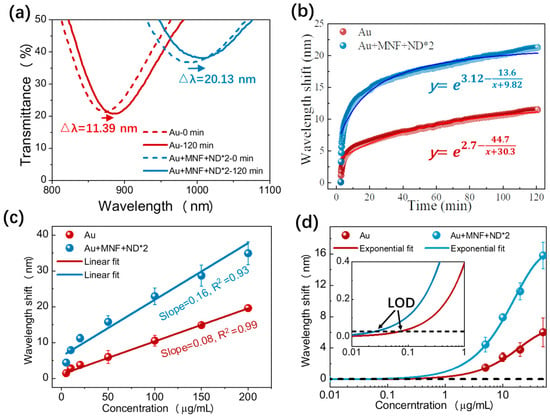
Figure 6.
(a) Transmission spectra of the Au and Au + MNF + ND*2 chips incubated with 150 μg/mL goat-anti-mouse IgG solution at 0 and 120 min. (b) Real-time resonant wavelength shift during incubation. (c) Wavelength shifts of the two chips at varied mouse IgG concentration solutions. (d) Exponential fits at low concentration range.
Then, the chips immobilized antibodies were incubated with mouse IgG solutions under varied concentrations to evaluate immunoassay performance. The dependence of resonant wavelength shift on concentration is presented in Figure 6c. As the concentration increased, the resonant wavelength shift increased due to more antigens linked on the chip surface. For a given antigen concentration, Au + MNF + ND*2 chip showed a larger redshift because of the improved RI sensitivity and antibody loading amount of MNF and ND. Linear fittings were carried out within the whole measurement range to evaluate the IgG detection sensitivity, and the sensitivity improved from 0.08 to 0.16 nm/(μg/mL) after MNF + ND*2 were deposited. Correspondingly, the limit of detection (LOD), defined as three times the standard deviation of the blank measurement, was lowered from 0.069 to 0.024 μg/mL [36].
To evaluate the specificity, the goat-anti-mouse IgG functionalized Au and Au + MNF + ND*2 chips were incubated with rabbit IgG, bovine IgG, mouse IgG, and BSA in PBS solution, respectively. Compared with the case of mouse IgG, the wavelength shifts induced by all the other analytes were much less for both the Au and Au + MNF + ND*2 chip (Figure 7), demonstrating a good specificity of the proposed immunoassay.
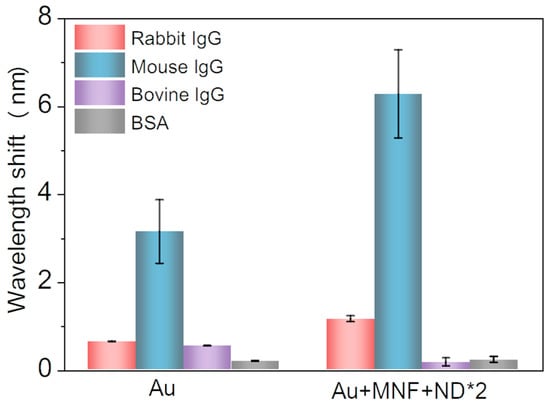
Figure 7.
Measurement results of specificity experiments. Resonant wavelength shifts induced by different proteins under a fixed concentration for Au and Au + MNF + ND*2 chips.
To have a more complete assessment of the proposed sensor, a comparison of the reported nanomaterials-modified SPR sensors in RI sensitivity and biological LOD is summarized in Table 1. Our proposed MNF and ND co-engineered sensor not only possesses much higher RI sensitivity but also shows a competitive LOD for IgG immunoassay. This is mainly attributed to the deposited MNF and ND modulating the plasmonic surface and enhancing the sensing field, and their special petal-like morphology exposing more faces and edge sites for antibodies to bind more antigens.

Table 1.
Comparison with nanomaterial-modified SPR sensors for IgG immunoassay.
3.4. PRV Immunoassay Performance
Porcine pseudorabies caused by PRV is an acute septic epidemic to which livestock and wildlife are susceptible, and developing a detection method for the diagnosis of wild-type PRV infection is important [44]. Here, our proposed SPR sensing scheme has also been demonstrated for sensitivity-enhanced PRV detection in a serum environment. PRV antibody was immobilized on the chip surface for immunoassay of PRV. The Au and Au + MNF + NDs*2 chips were incubated with 40 μg/mL PRV antibody for 60 min. The resonant wavelength shifts over time are shown in Figure S5. As similar to the case of goat-anti-mouse IgG, the PRV antibody immobilization-induced shift amount for Au + MNF + NDs*2 chip (11.49 nm) was larger than that for the Au chip (8.02 nm). Then, the two chips were incubated with different concentrations of PRV in serum solutions. The redshifts at different concentrations from 0.5 to 10 μg/mL were presented in Figure 8. Both chips perform an accumulated increase of resonant wavelength shift as the increase of concentration. Moreover, the Au + MNF + NDs*2 chip shows more redshift amount at each concentration. As a result, the LOD was lowered from 0.024 μg/mL (Au chip) to 0.018 μg/mL (Au + MNF + ND*2 chip), which was far lower than the proposed result by direct immunoassay of PRV [44].
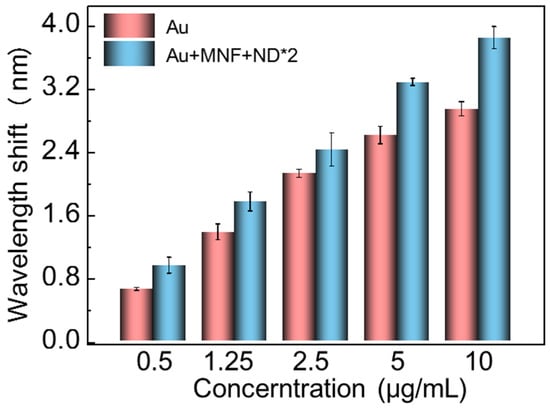
Figure 8.
Resonant wavelength shifts of Au and Au + MNF + ND*2 chips at different PRV concentrations in serum solutions.
4. Conclusions
In summary, an MNF and ND co-engineered SPR scheme was proposed and applied to the immunoassay of IgG and PRV. The scheme can be easily implemented by physically depositing an MNF and ND overlayer on the gold surface of an SPR chip, and the overlayer can be flexibly adjusted by controlling the deposition times to approach the optimal performance. The sensing performances of bulk RI, IgG, and PRV were investigated. It was found that the optimal deposition condition was MNF + ND*2, which improved the bulk RI sensitivity from 9658 to 12,219 nm/RIU. When applied to the IgG immunoassay, the Au + MNF + ND*2 chip showed a higher sensitivity of 0.16 nm/(μg/mL) than the 0.08 nm/(μg/mL) for Au chip, correspondingly lowering the LOD from 0.069 to 0.024 μg/mL. Characterization and simulation results showed that the improvement arose from the enhanced sensing field and increased antibody loading by the deposition of MNF and ND on the Au surface. The specificity of the sensor was also demonstrated through experimentation. Besides, the sensor was realistically applied to PRV immunoassay in a serum environment, and the LOD of 0.018 μg/mL for Au + MNF + ND*2 chip was achieved. This value was far lower than the proposed result by direct detection of PRV. The excellent performance of the proposed sensor is owing to the high RI and rich edge sites that provide more sites for the immobilization of a larger amount of antibodies. Because of its simple scheme and easy implementation, the proposed sensor provides an efficient and high-performance platform for biological detection.
Supplementary Materials
The following supporting information can be downloaded at: https://www.mdpi.com/article/10.3390/bios13050506/s1. Figure S1: Schematic diagram of the SPR test system; Figure S2: Characterization section; Figure S3: Bulk RI test results; Figure S4: Simulations; Figure S5: PRV measurement.
Author Contributions
Y.C. (Yaofei Chen): Conceptualization, writing-original draft, writing-review and editing, funding acquisition, supervision. X.X.: Experimental, formal analysis, data curation, investigation. Y.C. (Yu Chen): Experimental, formal analysis, data curation, investigation. L.C.: Formal analysis, software. G.L.: Writing-review and editing, methodology. W.X.: Resources, validation, writing-review and editing, supervision. J.S.: Resources, methodology. Z.C.: Conceptualization, resources, project administration. Y.L.: Conceptualization, methodology, writing-review and editing, funding acquisition, project administration. All authors have read and agreed to the published version of the manuscript.
Funding
This work is supported by the National Natural Science Foundation of China (NSFC) (62175094, 62275109, 61805108, 61904067, 62075088); Basic and Applied Basic Research Foundation of Guangdong province (2022A1515011671, 2022A1515010272); Basic and Applied Basic Research Foundation of Guangzhou (202102020758, 202201010553); Science and Technology R&D Project of Shenzhen (JSGG20201102163800003, JSGG20210713091806021); The science foundation of Guangdong Second Provincial General Hospital (TJGC-2021019); Fundamental Research Funds for the Central Universities (21621405, 21620328); The Open Fund of the Guangdong Provincial Key Laboratory of Optical Fiber Sensing and Communications (Jinan University).
Institutional Review Board Statement
Not applicable.
Informed Consent Statement
Not applicable.
Data Availability Statement
We would happily provide the data upon request.
Conflicts of Interest
The authors declare no conflict of interest.
References
- Guha, A.; Ahmad, O.S.; Guerreiro, A.; Karim, K.; Sandström, N.; Ostanin, V.P.; van der Wijngaart, W.; Piletsky, S.A.; Ghosh, S.K. Direct detection of small molecules using a nano-molecular imprinted polymer receptor and a quartz crystal resonator driven at a fixed frequency and amplitude. Biosens. Bioelectron. 2020, 158, 112176. [Google Scholar] [CrossRef] [PubMed]
- Yang, X.; Gong, C.; Wang, Y.; Luo, Y.; Rao, Y.-J.; Peng, G.-D.; Gong, Y. A sequentially bioconjugated optofluidic laser for wash-out-free and rapid biomolecular detection. Lab A Chip 2021, 21, 1686–1693. [Google Scholar] [CrossRef] [PubMed]
- Zavatski, S.; Popov, A.I.; Chemenev, A.; Dauletbekova, A.; Bandarenka, H. Wet Chemical Synthesis and Characterization of Au Coatings on Meso-and Macroporous Si for Molecular Analysis by SERS Spectroscopy. Crystals 2022, 12, 1656. [Google Scholar] [CrossRef]
- Masson, J.F. Surface Plasmon Resonance Clinical Biosensors for Medical Diagnostics. ACS Sens. 2017, 2, 16–30. [Google Scholar] [CrossRef] [PubMed]
- Shalabney, A.; Abdulhalim, I. Sensitivity-enhancement methods for surface plasmon sensors. Laser Photonics Rev. 2011, 5, 571–606. [Google Scholar] [CrossRef]
- Wang, Q.; Jing, J.-Y.; Wang, X.-Z.; Niu, L.-Y.; Zhao, W.-M. A D-Shaped Fiber Long-Range Surface Plasmon Resonance Sensor With High Q-Factor and Temperature Self-Compensation. IEEE Trans. Instrum. Meas. 2020, 69, 2218–2224. [Google Scholar] [CrossRef]
- Zeng, S.; Baillargeat, D.; Ho, H.-P.; Yong, K.-T. Nanomaterials enhanced surface plasmon resonance for biological and chemical sensing applications. Chem. Soc. Rev. 2014, 43, 3426–3452. [Google Scholar] [CrossRef]
- Jing, J.; Liu, K.; Jiang, J.; Xu, T.; Wang, S.; Ma, J.; Zhang, Z.; Zhang, W.; Liu, T. Performance improvement approaches for optical fiber SPR sensors and their sensing applications. Photonics Res. 2022, 10, 126–147. [Google Scholar] [CrossRef]
- Cai, H.; Wang, M.; Liu, J.; Wang, X. Theoretical and experimental study of a highly sensitive SPR biosensor based on Au grating and Au film coupling structure. Opt. Express 2022, 30, 26136. [Google Scholar] [CrossRef]
- Yan, R.; Wang, T.; Yue, X.; Wang, H.; Zhang, Y.-H.; Xu, P.; Wang, L.; Wang, Y.; Zhang, J. Highly sensitive plasmonic nanorod hyperbolic metamaterial biosensor. Photonics Res. 2022, 10, 84–95. [Google Scholar] [CrossRef]
- Sreekanth, K.V.; Alapan, Y.; ElKabbash, M.; Ilker, E.; Hinczewski, M.; Gurkan, U.A.; De Luca, A.; Strangi, G. Extreme sensitivity biosensing platform based on hyperbolic metamaterials. Nat. Mater. 2016, 15, 621–627. [Google Scholar] [CrossRef] [PubMed]
- Wu, F.; Thomas, P.A.; Kravets, V.G.; Arola, H.O.; Soikkeli, M.; Iljin, K.; Kim, G.; Kim, M.; Shin, H.S.; Andreeva, D.V.; et al. Layered material platform for surface plasmon resonance biosensing. Sci. Rep. 2019, 9, 20286. [Google Scholar] [CrossRef] [PubMed]
- Kazanskiy, N.L.; Khonina, S.N.; Butt, M.A.; Kaźmierczak, A.; Piramidowicz, R. A numerical investigation of a plasmonic sensor based on a metal-insulator-metal waveguide for simultaneous detection of biological analytes and ambient temperature. Nanomaterials 2021, 11, 2551. [Google Scholar] [CrossRef] [PubMed]
- Li, C.; Gao, J.; Shafi, M.; Liu, R.; Zha, Z.; Feng, D.; Liu, M.; Du, X.; Yue, W.; Jiang, S. Optical fiber SPR biosensor complying with a 3D composite hyperbolic metamaterial and a graphene film. Photonics Res. 2021, 9, 379–388. [Google Scholar] [CrossRef]
- Hu, S.; Chen, Y.; Chen, Y.; Chen, L.; Zheng, H.; Azeman, N.H.; Liu, M.X.; Liu, G.-S.; Luo, Y.; Chen, Z. High-performance fiber plasmonic sensor by engineering the dispersion of hyperbolic metamaterials composed of Ag/TiO2. Opt. Express 2020, 28, 25562–25573. [Google Scholar] [CrossRef]
- Hu, S.; Shi, W.; Chen, Y.; Chen, Y.; Liu, G.-S.; Chen, L.; Luo, Y.; Chen, Z. Dispersion Management for Hyperbolic-Metamaterials Based Surface Plasmon Resonance Sensor Towards Extremely High Sensitivity. J. Light. Technol. 2022, 40, 887–893. [Google Scholar] [CrossRef]
- Hu, S.; Shi, W.; Chen, Y.; Yuan, J.; Xiong, X.; Liu, T.; Ding, S.; Xiao, W.; Chen, Y.; Liu, G.S.; et al. Universal and flexible design for high-sensitivity and wide-ranging surface plasmon resonance sensors based on a three-dimensional tuning hypersurface. Sens. Actuators B Chem. 2023, 380, 133284. [Google Scholar] [CrossRef]
- Mao, Z.; Peng, X.; Zhou, Y.; Liu, Y.; Koh, K.; Chen, H. Review of Interface Modification Based on 2D Nanomaterials for Surface Plasmon Resonance Biosensors. ACS Photonics 2022, 9, 3807–3823. [Google Scholar] [CrossRef]
- Wang, Q.; Zou, L.; Yang, X.; Liu, X.; Nie, W.; Zheng, Y.; Cheng, Q.; Wang, K. Direct quantification of cancerous exosomes via surface plasmon resonance with dual gold nanoparticle-assisted signal amplification. Biosens. Bioelectron. 2019, 135, 129–136. [Google Scholar] [CrossRef]
- Zhang, H.; Chen, Y.; Wang, H.; Hu, S.; Xia, K.; Xiong, X.; Huang, W.; Lu, H.; Yu, J.; Guan, H.; et al. Titanium dioxide nanoparticle modified plasmonic interface for enhanced refractometric and biomolecular sensing. Opt. Express 2018, 26, 33226–33237. [Google Scholar] [CrossRef]
- Yang, M.; Xiong, X.; He, R.; Luo, Y.; Tang, J.; Dong, J.; Lu, H.; Yu, J.; Guan, H.; Zhang, J.; et al. Halloysite nanotube-modified plasmonic interface for highly sensitive refractive index sensing. ACS Appl. Mater. Interfaces 2018, 10, 5933–5940. [Google Scholar] [CrossRef] [PubMed]
- Xiong, X.; Chen, Y.; Wang, H.; Hu, S.; Luo, Y.; Dong, J.; Zhu, W.; Qiu, W.; Guan, H.; Lu, H.; et al. Plasmonic interface modified with graphene oxide sheets overlayer for sensitivity enhancement. ACS Appl. Mater. Interfaces 2018, 10, 34916–34923. [Google Scholar] [CrossRef] [PubMed]
- Miyazaki, C.M.; Camilo, D.E.; Shimizu, F.M.; Ferreira, M. Improved antibody loading on self-assembled graphene oxide films for using in surface plasmon resonance immunosensors. Appl. Surf. Sci. 2019, 490, 502–509. [Google Scholar] [CrossRef]
- Luo, Y.; Hu, S.; Wang, H.; Chen, Y.; Dong, J.; Jiang, Z.; Xiong, X.; Zhu, W.; Qiu, W.; Lu, H.; et al. Sensitivity-enhanced surface plasmon sensor modified with MoSe2 overlayer. Opt. Express 2018, 26, 34250–34258. [Google Scholar] [CrossRef] [PubMed]
- Zhao, Y.; Gan, S.; Wu, L.; Zhu, J.; Xiang, Y.; Dai, X. GeSe nanosheets modified surface plasmon resonance sensors for enhancing sensitivity. Nanophotonics 2019, 9, 327–336. [Google Scholar] [CrossRef]
- Wu, Q.; Li, N.; Wang, Y.; Liu, Y.; Xu, Y.; Wei, S.; Wu, J.; Jia, G.; Fang, X.; Chen, F.; et al. A 2D transition metal carbide MXene-based SPR biosensor for ultrasensitive carcinoembryonic antigen detection. Biosens. Bioelectron. 2019, 144, 111697. [Google Scholar] [CrossRef] [PubMed]
- Xue, T.; Liang, W.; Li, Y.; Sun, Y.; Xiang, Y.; Zhang, Y.; Dai, Z.; Duo, Y.; Wu, L.; Qi, K.; et al. Ultrasensitive detection of miRNA with an antimonene-based surface plasmon resonance sensor. Nat. Commun. 2019, 10, 28. [Google Scholar] [CrossRef]
- Shi, X.; Posysaev, S.; Huttula, M.; Pankratov, V.; Hoszowska, J.; Dousse, J.C.; Zeeshan, F.; Niu, Y.; Zakharov, A.; Cao, W.; et al. Metallic contact between MoS2 and Ni via Au nanoglue. Small 2018, 14, 1704526. [Google Scholar] [CrossRef]
- Zhao, P.; Chen, Y.; Chen, Y.; Hu, S.; Chen, H.; Xiao, W.; Liu, G.; Tang, Y.; Shi, J.; He, Z.; et al. A MoS2 nanoflower and gold nanoparticle-modified surface plasmon resonance biosensor for a sensitivity-improved immunoassay. J. Mater. Chem. C 2020, 8, 6861–6868. [Google Scholar] [CrossRef]
- Chen, Y.; Chen, Y.; Shi, W.; Hu, S.; Huang, Q.; Liu, G.S.; Shi, J.; Chen, L.; Azeman, N.H.; Bakar, A.A.A.; et al. MoS2-nanoflower enhanced programmable adsorption/desorption plasmonic detection for bipolar-molecules with high sensitivity. Biosens. Bioelectron. 2022, 198, 113787. [Google Scholar] [CrossRef]
- Mao, P.; Luo, Y.; Chen, C.; Peng, S.; Feng, X.; Tang, J.; Fang, J.; Zhang, J.; Lu, H.; Yu, J.; et al. Design and optimization of surface plasmon resonance sensor based on multimode fiber. Opt. Quantum Electron. 2015, 47, 1495–1502. [Google Scholar] [CrossRef]
- Ye, M.; Winslow, D.; Zhang, D.; Pandey, R.; Yap, Y.K. Recent advancement on the optical properties of two-dimensional molybdenum disulfide (MoS2) thin films. Photonics 2015, 2, 288–307. [Google Scholar] [CrossRef]
- Wang, X.; Ding, J.; Yao, S.; Wu, X.; Feng, Q.; Wang, Z.; Geng, B. High supercapacitor and adsorption behaviors of flower-like MoS2 nanostructures. J. Mater. Chem. A 2014, 2, 15958–15963. [Google Scholar] [CrossRef]
- Huang, Q.Z.; Fang, Y.; Shi, J.; Liang, Y.L.; Zhu, Y.Q.; Xu, G. Flower-like molybdenum disulfide for polarity-triggered accumulation/release of small molecules. ACS Appl. Mater. Interfaces 2017, 9, 36431–36437. [Google Scholar] [CrossRef] [PubMed]
- Torelli, M.D.; Nunn, N.A.; Shenderova, O.A. A perspective on fluorescent nanodiamond bioimaging. Small 2019, 15, 1902151. [Google Scholar] [CrossRef] [PubMed]
- Liu, C.; Cai, Q.; Xu, B.; Zhu, W.; Zhang, L.; Zhao, J.; Chen, X. Graphene oxide functionalized long period grating for ultrasensitive label-free immunosensing. Biosens. Bioelectron. 2017, 94, 200–206. [Google Scholar] [CrossRef] [PubMed]
- Wang, Q.; Jing, J.-Y.; Wang, B.-T. Highly Sensitive SPR Biosensor Based on Graphene Oxide and Staphylococcal Protein A Co-Modified TFBG for Human IgG Detection. IEEE Trans. Instrum. Meas. 2019, 68, 3350–3357. [Google Scholar] [CrossRef]
- Jiang, W.-S.; Xin, W.; Xun, S.; Chen, S.-N.; Gao, X.-G.; Liu, Z.-B.; Tian, J.-G. Reduced graphene oxide-based optical sensor for detecting specific protein. Sens. Actuators B Chem. 2017, 249, 142–148. [Google Scholar] [CrossRef]
- Zhang, H.; Sun, Y.; Gao, S.; Zhang, H.; Zhang, J.; Bai, Y.; Song, D. Studies of gold nanorod-iron oxide nanohybrids for immunoassay based on SPR biosensor. Talanta 2014, 125, 29–35. [Google Scholar] [CrossRef]
- Liu, K.; Zhang, J.; Jiang, J.; Xu, T.; Wang, S.; Chang, P.; Zhang, Z.; Ma, J.; Liu, T. MoSe2-Au Based Sensitivity Enhanced Optical Fiber Surface Plasmon Resonance Biosensor for Detection of Goat-Anti-Rabbit IgG. IEEE Access 2019, 8, 660–668. [Google Scholar] [CrossRef]
- Zhang, D.; Sun, Y.; Wu, Q.; Ma, P.; Zhang, H.; Wang, Y.; Song, D. Enhancing sensitivity of surface plasmon resonance biosensor by Ag nanocubes/chitosan composite for the detection of mouse IgG. Talanta 2016, 146, 364–368. [Google Scholar] [CrossRef] [PubMed]
- Mai, Z.; Zhang, J.; Chen, Y.; Wang, J.; Hong, X.; Su, Q.; Li, X. A disposable fiber optic SPR probe for immunoassay. Biosens. Bioelectron. 2019, 144, 111621. [Google Scholar] [CrossRef] [PubMed]
- Wu, Q.; Song, D.; Zhang, D.; Sun, Y. An enhanced SPR immunosensing platform for human IgG based on the use of silver nanocubes and carboxy-functionalized graphene oxide. Microchim. Acta 2016, 183, 2177–2184. [Google Scholar] [CrossRef]
- Huang, L.; Xiao, W.; Xu, T.; Chen, H.; Jin, Z.; Zhang, Z.; Song, Q.; Tang, Y. Miniaturized Paper-Based Smartphone Biosensor for Differential Diagnosis of Wild-type Pseudorabies Virus Infection versus Vaccination Immunization. Sens. Actuators B Chem. 2021, 327, 128893. [Google Scholar] [CrossRef]
Disclaimer/Publisher’s Note: The statements, opinions and data contained in all publications are solely those of the individual author(s) and contributor(s) and not of MDPI and/or the editor(s). MDPI and/or the editor(s) disclaim responsibility for any injury to people or property resulting from any ideas, methods, instructions or products referred to in the content. |
© 2023 by the authors. Licensee MDPI, Basel, Switzerland. This article is an open access article distributed under the terms and conditions of the Creative Commons Attribution (CC BY) license (https://creativecommons.org/licenses/by/4.0/).